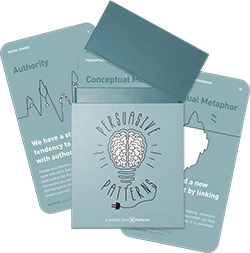Halo Effect
Design Pattern
Alternate titles: Halo Error.
Problem summary
We let impressions created in one area influence opinions in another area
Usage
- Attractive products work better – use the Halo effect to have your users generally rate the experience of your product higher.
This card is part of the Persuasive Patterns printed card deck
The Persuasive Patterns Card Deck is a collection of 60 design patterns driven by psychology, presented in a manner easily referenced and used as a brainstorming tool.
Get your deck!Solution
- First impressions matter. The Halo effect depicts that people do judge a book by its cover. Having a good initial experience with a product tends leads to higher rating of intuitiveness, reliability, and security of the rest of your product and experience.
- Spillovers happen. People’s perception of one aspect of an organisation, such as its customer service, can influence how people perceive the rest of its operations and the company as a whole.
Rationale
We tend to like (or dislike) everything about a person – including things we have not observed. We strive toward maintaining a simple and coherent view of the world and suppress ambiguity. We interpret things in a way that makes them coherent with the context. The halo (positive) and horn (negative) effects increases the weight of first impressions – sometimes to the point that subsequent information is mostly wasted.
Consumers are willing to pay more money for a brand they already know and trust. Subsequent new products by a brand will benefit from the brand’s halo effect.
Discussion
The halo effect was originally identified in 1907 by the American psychologist Frederick L. Wells (1884-1964), but only officially recognized and coined as a term by psychologist Edward Thorndike in 1920. Thorndike originally coined the term referring only to people; however, its use has been greatly expanded especially in the area of brand marketing.
The opposite of the halo effect is the horn effect, named for the horns of the devil. When consumers have an unfavorable experience, they correlate that negative experience with everything associated with a brand.
1 Thorndike, E.L. (1920). “A constant error in psychological ratings”. Journal of Applied Psychology. 4 (1): 25–29. doi:10.1037/h0071663
2 Halo effect by Mitchell Grant
4 The Halo Effect in Consumer Perception: Why Small Details Can Make a Big Difference by Itamar Shatz
5 Halo Effect at Learning Loop
User Interface Design Patterns
- Forms
- Explaining the process
- Community driven
- Tabs
- Jumping in hierarchy
- Menus
- Content
- Gestures
- Tables
- Formatting data
- Images
- Search
- Reputation
- Social interactions
- Shopping
- Increasing frequency
- Guidance
- Registration
Persuasive Design Patterns
- Loss Aversion
- Other cognitive biases
- Scarcity
- Gameplay design
- Fundamentals of rewards
- Gameplay rewards


